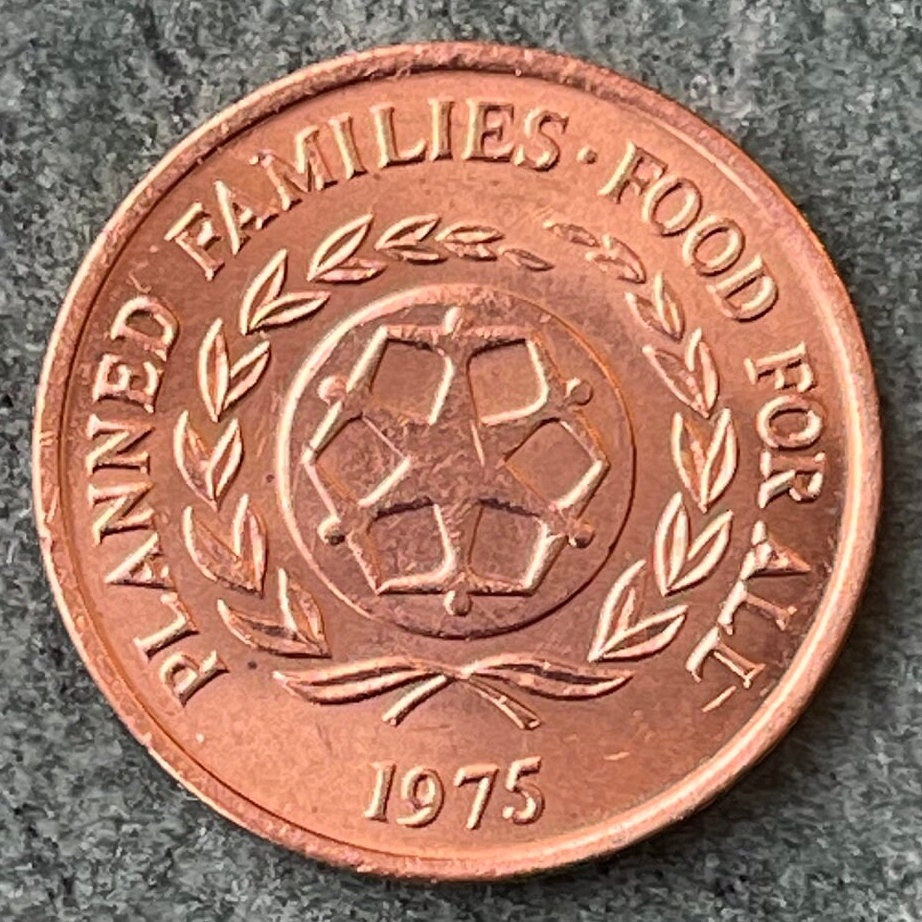elemintalshop
Watermelons 2 Seniti Tonga Authentic Coin Money for Jewelry and Craft Making (Family Planning)
Watermelons 2 Seniti Tonga Authentic Coin Money for Jewelry and Craft Making (Family Planning)
Couldn't load pickup availability
Watermelons 2 Seniti Tonga Authentic Coin Money for Jewelry and Craft Making (Family Planning)
Commemorative issue: FAO - Family Planning
Reverse: Two Watermelons
Lettering: TONGA
2 SENITI
Obverse: UN Emblem of Family Planning
Lettering: PLANNED FAMILIES·FOOD FOR ALL
Features
Issuer Tonga
King Tāufaʻāhau Tupou IV (1965-2006)
Type Circulating commemorative coin
Years 1975-1979
Value 2 Seniti
0.02 TOP = USD 0.0089
Currency Paʻanga (1967-date)
Composition Bronze
Weight 3.9 g
Diameter 21 mm
Thickness 1.6 mm
Shape Round
Technique Milled
Orientation Medal alignment ↑↑
Number N# 7862
References KM# 43, Schön# 28
WIkipedia:
Watermelon (Citrullus lanatus) is a flowering plant species of the Cucurbitaceae family and the name of its edible fruit. A scrambling and trailing vine-like plant, it is a highly cultivated fruit worldwide, with more than 1,000 varieties.
Watermelon is grown in favorable climates from tropical to temperate regions worldwide for its large edible fruit, which is a berry with a hard rind and no internal divisions, and is botanically called a pepo. The sweet, juicy flesh is usually deep red to pink, with many black seeds, although seedless varieties exist. The fruit can be eaten raw or pickled, and the rind is edible after cooking. It may also be consumed as a juice or as an ingredient in mixed beverages.
Watermelons are thought to be native to northeastern Africa. Wild watermelon seeds have been found in Uan Muhuggiag, a prehistoric site in Libya that dates to approximately 3500 BC. Watermelons were domesticated in Egypt by 2000 BC, though they were not the sweet modern variety. Sweet dessert watermelons spread across the Mediterranean world during Roman times.
Considerable breeding effort has developed disease-resistant varieties. Many cultivars are available that produce mature fruit within 100 days of planting. In 2017, China produced about two-thirds of the world total of watermelons.
*********
During the 1996 World Food Summit (WFS), a Plan of Action was adopted with the aim of reducing the number of undernourished people to half their 1996 number by 2015.
The Plan of Action contained seven commitments which were to act as guiding principles to all those involved in formulating the policies to implement the Plan of Action at national and international levels. The FAO Committee on World Food Security (CFS), which had been the negotiating forum for the preparation of the WFS, was appointed to monitor progress at regular intervals and, at its June 1998 session, it presented a first review of the action taken to fulfil each of the seven commitments, at national and international levels, during 1997. This review was based on reports contributed by about 100 countries and 33 United Nations agencies, international organizations, regional or subregional bodies and non-governmental organizations (NGOs).
Many of the countries covered by the CFS review had introduced institutional measures to support the Plan of Action and its aims. These included: establishing interministerial coordination mechanisms; reviewing national strategies in the light of WFS objectives; and developing national plans of action. More specifically, Food for All campaigns and other initiatives, including World Food Day celebrations, had been carried out with a view to raising public awareness of food security issues.
Share



















